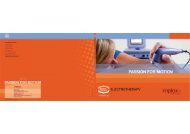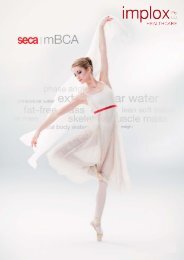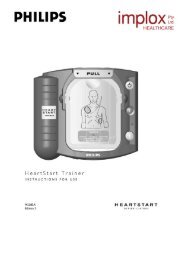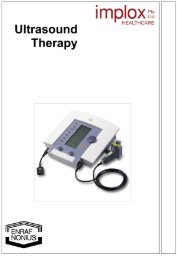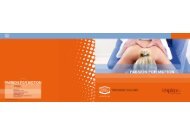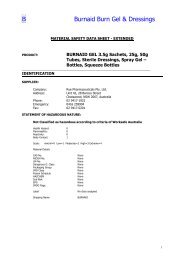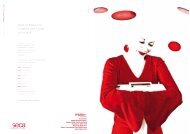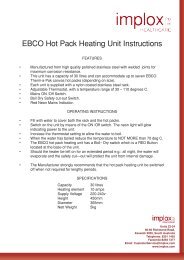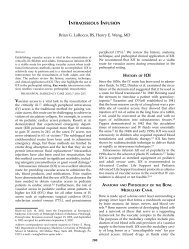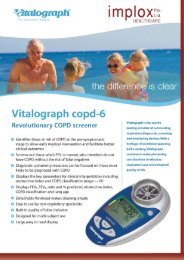Low and medium Frequency Electrotherapy - Implox
Low and medium Frequency Electrotherapy - Implox
Low and medium Frequency Electrotherapy - Implox
You also want an ePaper? Increase the reach of your titles
YUMPU automatically turns print PDFs into web optimized ePapers that Google loves.
Percentage type I (tonic) muscle fibres<br />
M. gastrocnemius 46,9 – 56,9 %<br />
M. gluteus maximus 41,2 – 71,5 %<br />
M. iliopsoas 37,0 – 60,9 %<br />
M. tibialis anterior 56,6 – 80,5 %<br />
M. soleus 69,8 – 100,0 %<br />
M. vastus medialis 53,5 – 79,8 %<br />
The figue shows the average percentage of the fibre type to an accuracy of 95%.<br />
Table 3.<br />
Distribution of fibre types in various muscles according to Johnson (9) .<br />
It can also be assumed that unmodulated alternating currents with frequencies above 3000 Hz will not affect the<br />
distribution of the muscle fibres. If modulated alternating currents are applied, a depolarization pattern can be<br />
imposed on the axons. At low frequencies, up to about 20 Hz, the muscle tends to become ‘redder’, while at higher<br />
frequencies, up to about 150 Hz, the muscle tends to become ‘whiter’.<br />
5.3 Application of alternating currents for muscle strengthening<br />
As stated in chapter 2, both <strong>medium</strong>-frequency alternating currents <strong>and</strong> TENS current types are able to provide<br />
selective stimulation of the motor neurons (see graphs of Lullies <strong>and</strong> Howson).<br />
5.3.1 Medium-frequency alternating current<br />
Muscle contractions can be produced with <strong>medium</strong>-frequency alternating current at any frequency between 1000 <strong>and</strong><br />
4000 Hz. However, the maximum depolarization frequency is dependent on the absolute refractory period. The length<br />
of this period is, in turn, dependent on the conduction velocity of the nerve fibre (2) . There appears to be a linear<br />
relationship between the conduction velocity <strong>and</strong> the absolute refractory period. For rapidly conducting fibres, such as<br />
the Aa 1 fibre, the absolute refractory period is approx. 0.2 ms. Consequently, the maximum depolarization frequency<br />
is around 2500 Hz (1000 ms : 0,4 ms = 2500). This frequency is used in the ‘Russian Stimulation’ muscle<br />
strengthening technique.<br />
Depending on the desired effect, <strong>medium</strong>-frequency alternating currents can be divided into:<br />
a. Modulated alternating current with a frequency of 2000-4000 Hz.<br />
This current type is used where the objective is to change the distribution of muscle fibres (twitch speed). The AMF is<br />
used to affect the muscle fibre distribution.<br />
A change in the distribution of muscle fibres can be achieved with interferential current <strong>and</strong> the use of the AMF. At<br />
a low AMF, up to about 20 Hz, the muscle becomes ‘redder’, while at a higher AMF, up to about 150 Hz, the muscle<br />
becomes ‘whiter’. This method can be used to increase the explosive release of energy in high-jumpers, provided<br />
that is supplemented by functional exercises. The most comfortable tetanic contractions are obtained at an AMF<br />
between 40 <strong>and</strong> 80 Hz.<br />
The treatment is applied in cycles of one minute. The minute is dived up as follows:<br />
• during the first 10 seconds the amplitude is increased until a strong contraction occurs (from the motor stimulation<br />
level up to the limit of tolerance). The amplitude should preferably be set by the patient;<br />
• the contraction is maintained for 20 seconds. If the tension in the muscle decreases during this period<br />
(accommodation), the current amplitude is increased;<br />
• the stimulation is followed by a pause of at least 30 seconds.<br />
The number of contractions per treatment is 15-20, so that the treatment lasts a corresponding number of minutes.<br />
The treatment frequency is from daily to at least three times per week.<br />
b. Unmodulated (continuous) alternating current with a frequency of 2000-4000 Hz.<br />
This current type is used where the objective is to strengthen the muscle without affecting the fibre distribution.<br />
29



